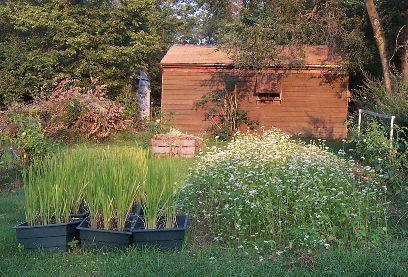
Rice Cultivation
August 27, 2003 Photo Update

August 27, 2003 Photo Update
In 2003, our unusually wet spring was followed by a wet summer. The lawn grass that would normally be brown, by mid-July, has remained emerald green. We are now two thirds of the way through our rice growing season, and the plants are beginning to head up.

This particular variety of rice is a very old strain, and the heads point straight up to heaven, for a very long time. They will not begin to bow for many days. The grain is still tender and green.
In late August, there is a lot happening in the garden, and in the natural world beyond. The climate has been near-tropical, for several weeks, and the world is full of life. The nighttime summer symphony of frogs and insects has spilled over into the day. Now, the whole land vibrates with the song of the cricket, the katydid, cicada, and the wind through the leaves. Different times of day yield different sounds and the mood changes with the pitch of the sun and phase of the moon. On a warm, humid night, Mars rules the southern sky.
With so much happening, it's a good time to talk about the little miracles that have appeared in the garden. I've discovered a planting rhythm that seems to work, very well.

May 2003. Young Garlic. |

August 2003. Young Buckwheat. |
You can see how well the rice has grown, through rain and shine. Now, check out the area to the right of the mini-paddies. We plant our garlic cloves in November, close to Thanksgiving, then cover the area with 4 to 6 inches of wheat straw. The garlic winters over and is ready to dig and hang, in early July.
A few days after the garlic harvest, I broadcast some buckwheat seeds in the same area, then I lightly raked the soil. From what I understand, the buckwheat will be ready to harvest, 60 to 70 days after planting. That will be mid to late September. The plan is to thresh the grain and to work the straw into the soil, with plenty of time to put in next year's garlic.
Meanwhile, I have another grain in the garden and its presence is beautiful. The blooms are featured at the top of this page. Buckwheat is not a true grass. Unlike rice, barley, millet, corn, oats and wheat, it is a dichotomous plant; having forked veins in the leaf. With grass, the veins all run parallel. Traditionally, buckwheat is grown in northern Europe and Asia. It has a relatively fast growing season, so it is well suited for cooler climates with short summers and it has another helpful characteristic. It is energy food! Keeping you warm and active in the middle of winter.

May 2003. |

August 2003. |
I love to do these "before and after" pictures. And I never cease to be fascinated by the life force that rests in the heart of every grain, every seed. How could I bring myself to modify rice seeds, so that they would produce toxic products, as they grow, or so they would produce heads full of grain that is barren, and cannot bring forth future seasons of rice? I would have to be insane. There is no amount of power, fame or money that could entice me to destroy a labor of thousands of years, of a hundred generations.
I have mentioned the summer symphony of insects, surrounding the garden. But, the rice is fine. It is not under attack. In a larger paddy, fish would feed on insects. The water would be flowing, difficult to breed mosquitoes. If an imbalance appears, the paddy is drained. All in respect, careful attention and harmony with the planet. And the result is a food that has not destroyed, but has enriched the land; a food that enriches our very health and reinforces our gratitude for the generations who have provided this priceless gift.
If we allow our rice and our wheat to disappear, to be replaced by commercially engineered bio-"food", then how, I wonder, will future generations remember us?

Before I close this update, I'd like to take another look at the "weed" patch. In this part of the world, these plants are called "Queen Ann's Lace" because of the lace-like trim of the flowers. In fact, these "weeds" are nothing less than wild carrots. Around here, the wild carrots are likely all descendants of carrots that have "escaped" cultivation. And they do very well, unattended, in this climate.
Carrots are bi-annuals. The first year, they grow a low, flowerless top and establish their roots. The second year, food stored in the root, supports vertical growth and flower development. In fact, you can buy a whole carrot at the market and plant it in the ground. If it survives the winter, you'll have "Queen Anne's Lace".
Pull some from the ground and smell the roots. The fragrance is unmistakable! We used to feed it to horses (and eat a little, as well). One word of caution. Look before you chomp! Wild carrots are very similar, in appearance, to poison hemlock and water hemlock. Both of those are fatal.